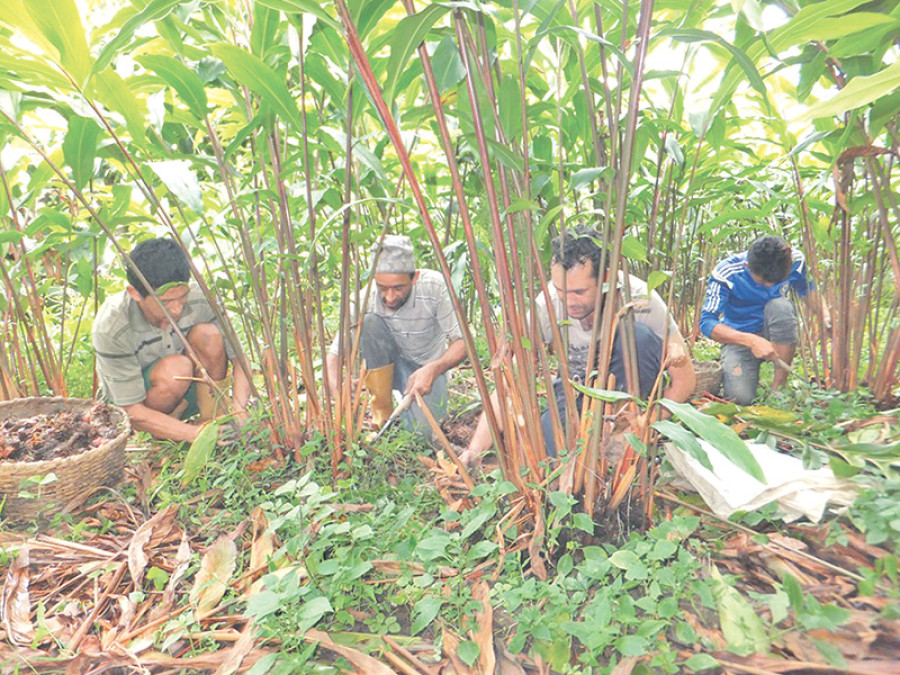Money
Nepali large cardamom being pushed out of world markets
Nepal’s organically grown large cardamom is gradually being pushed out of global markets as a handful of new players have started producing ‘duplicate’ products following a rise in demand for the high-value crop, a government finding shows.
Nepal’s organically grown large cardamom is gradually being pushed out of global markets as a handful of new players have started producing ‘duplicate’ products following a rise in demand for the high-value crop, a government finding shows.
The spice is identified as a niche product with increasing popularity among premium class consumers in the global market, but lately its market has started shrinking.
According to a report entitled National Sector Export Strategy of Large Cardamom 2017-21 released by the Ministry of Commerce recently, new competitors have entered the Pakistani market, the key large cardamom consuming country, and their products are significantly cheaper compared to Nepali and Indian large cardamom.
“In recent years, incentivized by the high economic return from large cardamom, major producers of green cardamom, namely Guatemala, China and Vietnam, began exporting ‘duplicate’ large cardamom to Pakistan,” the report said.
The ‘duplicate’ large cardamom is different in terms of shape and smell, but Pakistani merchants mix it with authentic Nepali large cardamom to reduce costs and boost profits, it said. This growing practice among traders in Pakistan has led to a decrease in large cardamom exports from India, and thus negatively impacted Nepal’s large cardamom sector. The price of large cardamom touched a new peak of Rs2,500 per kg in 2014 before plunging 66 percent to Rs850 per kg this year.
According to the Large Cardamom Entrepreneurs Association, the Chinese spice is brought into Nepal through illegal border crossings from India and is mixed with the Nepali product before being re-exported to India and third countries. The practice has eroded the quality of Nepali cardamom, it said.
According to the government report, Nepali suppliers have named the new product ‘duplicate’ cardamom because the taste is inferior, the size is larger and the pods split easily during cooking (which is a problem in biryani dishes where the pods are used to bring taste and removed before eating).
Traders mix whole pods of ‘duplicate’ cardamom with the Nepali product in a 25:75 ratio or even worse. Pakistanis and Afghanis snap them up due to the cheaper price, the report said.
India is Nepal’s largest large cardamom importer, purchasing approximately 99 percent of its large cardamom exports. The products are then packed and re-exported from India to Pakistan and the Middle East due to high demand and the high prices they fetch because of the preference for Nepali large cardamom.
Pakistan is the largest importer of large cardamom, purchasing roughly 60 percent of India’s large cardamom exports. The product is used in pods by the local Muslim community in biryani dishes, a Pakistani cuisine, as a symbol of prosperity and wealth.
The volume of large cardamom exports from Nepal grew modestly from 2004 to 2007, reached a peak of over 10,000 tonnes in 2008 and then started decreasing in 2009. However, the value of exports has not decreased due to continuous increases in world market prices. In the past two decades, the average export unit price of large cardamom has increased from $0.34 per kg to $12 per kg, the government report said.
The value of Nepal’s large cardamom exports rose from $7,440,000 in 2004 to $39.4 million in 2013. Since 2006, direct exports of large cardamom from Nepal to markets like Singapore, Pakistan and the United Arab Emirates have fallen to less than 1 percent.
Prices are normally determined by buyers in the Delhi market, according to the report. Large cardamom is graded into three categories—jumbo jet, standard and chalan chalti—and are priced accordingly.
The report said that wild large cardamom originated in Sikkim and Darjeeling in India and in eastern Nepal in ancient times. In 1830, large cardamom was cultivated by farmers in four districts in Nepal: Ilam, Taplejung, Panchthar and Bhojpur. It has been commercially grown only since 1853, when the Rana government took production and marketing initiatives.
In 1964, the government launched a policy of granting loans to farmers through the Agricultural Development Bank through the Mechi Development Fund. In 1965, large cardamom was sold for Rs2 per kg, a very low price compared with the recent record price of Rs2,500 per kg.
In 1976, the government set up a separate office called the Cardamom Development Centre primarily to support farmers. In the same year, Nepal celebrated Agricultural Year 2032-33 and the government received 400,000 large cardamom saplings of improved varieties (like Kopinge, Rangvang and Sawney ) from Sikkim to expand production, and distributed them to farmers in Panchthar, Ilam and Taplejung from Fikkal.
In 1982 the government declared four districts (Panchthar, Ilam, Bhojpur and Taplejung) as Large Cardamom Zone. Currently, large cardamom cultivation has expanded to 46 districts of the country with the acreage totalling 14,875 hectares and annual production exceeding 6,000 tonnes.
Nepal is the world’s largest producer of large cardamom. Other countries where this cultivar is produced are India and Bhutan. The average annual production of Nepal exceeds 6,600 tonnes, which is about 55 percent of the average annual world production of around 12,000 tonnes.




 19.12°C Kathmandu
19.12°C Kathmandu












